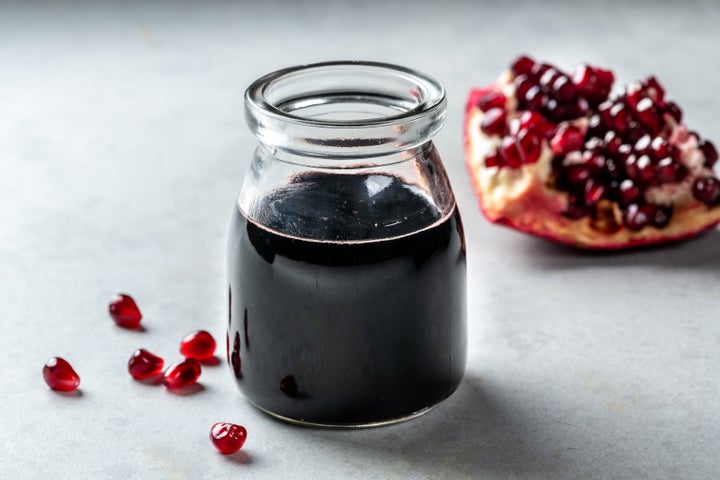
Molasses is the essential ingredient in gingerbread cookies, providing the chewy texture and almost burnt sugar flavor that characterizes the treat. But with so many varieties ― light versus blackstrap, sulfured versus unsulfured, and alternatives such as date and pomegranate ― there’s a broad debate on the right choice for gingerbread cookies. HuffPost interviewed several bakers about the merits of different types of molasses and what works best for gingerbread cookies.
What Is Molasses, Anyway?
Traditionally, sugar cane or sugar beets are crushed, boiled and reduced to make the sweet syrup we know and love, molasses. The first boil produces light molasses, and each further boil deepens the color and reduces the sugar content. This creates medium (also known as dark) molasses and then blackstrap. Molasses can be treated with sulfur dioxide to increase its shelf life, or it can remain in its pure form without any additions. You may note the terms “sulfured” or “unsulfured” on any iteration of the syrup.
Molasses can be derived from other sources as well, according to Joanne Slavin, a professor of nutritional food sciences at the University of Minnesota. These include white sugar, brown sugar and dried fruits like dates and pomegranates.
Light Molasses
With the highest sugar content of the bunch, light molasses is the most used variety among American bakers. “It’s just that: light — in flavor and texture— which gives it a mild sweetness,” said Elise Smith, the founder and owner of WinniE’s Bakery in Baltimore. “It gives all the ‘baking holiday cookies with grandma’ vibes.” In a pinch, you can substitute maple syrup for light molasses, which may also be listed as “sweet,” “first,” “mild,” or “Barbados” molasses.
The light variety might be your best bet for a chewier gingerbread, according to Melanie Bourdon, a chef and baker. “Light molasses is the sweetest and mildest out of the bunch because it is made from the first boiling cycle,” she said. “I like to use this type of molasses because it adds moisture to cookies, resulting in a soft and chewy texture.”

Medium Or Dark Molasses
The second boil results in medium or dark molasses, which has a deeper hue and a more robust flavor. “This is ultimately my first choice of molasses,” Bourdon said. “It adds enough bold flavor and sweet notes with a hint of bitterness to any recipe, which is exactly what you want for making gingerbread cookies.”
Bourdon added that it’s also versatile and can be used for marinades, baked beans, sauces, breads and recipes for other foods. This variety will contribute to a soft and slightly chewy gingerbread cookie.
Blackstrap Molasses
Beloved in health circles for containing beneficial minerals like iron and calcium, blackstrap has a bitter flavor and the lowest sugar content of the group. Though it’s ideal for savory foods such as barbecue sauces and stews, Bourdon cautioned against choosing blackstrap for cookies. “Please avoid this dark and bitter molasses for your baking recipes,” she said. “It will make your cookies dry and quite frankly inedible.
The rationale is basic chemistry. “Cookies need to have sugar and butter (or a similar solid fat) to ‘cream’ to get a good product,” Slavin said. “Any changes in the sugar or fat in the recipe will cause problems with cookie quality. As far as I can find, molasses is about 70% sugar and high in moisture, while blackstrap is 45% sugar, low in moisture, dense, bitter and salty.”
Remember to use blackstrap only when a recipe calls for the ingredient, such as with baked beans. But don’t sub in the sweetener for light or dark molasses.
Sulfured vs. Unsulfured
Choose unsulfured molasses when possible, since sulfur dioxide can leave an unpleasant, chemical-like aftertaste, according to Smith. “Unsulfured molasses is derived from processed mature sugar cane,” she said. “It’s rich in flavor with a smoky depth. The most natural. Commonly used for both cooking/baking and for alternative purposes. It’s very affordable.”
Date Molasses
Also known as date syrup, this sweetener is popular in the Middle East and can be easily made at home. Boil dates until plump, then puree and strain the liquid to get the sweet syrup. You may also find date syrup at your local supermarket or health food store, as its availability is increasing. Thinner than traditional American molasses, it has a concentrated caramel date flavor.
“[Date molasses] can be swapped for regular molasses since the texture and sweetness are very similar,” Bourdon told HuffPost. “I would recommend date molasses as a healthier choice, and it’s 100 percent vegan, which is not always the case for sugar-refined traditional molasses. (For those who don’t know, bone char from cattle bones is often used to make sugar).”
To compensate for the thinner texture of date molasses, Smith recommended increasing the amount of flour by 1 tablespoon until the cookie dough reaches the desired consistency. If this is your first time baking gingerbreads, your dough shouldn’t be sticky; it should almost be like Play-Doh.

Pomegranate Molasses
Another Middle Eastern ingredient, pomegranate molasses is closer in texture to its classic counterpart but has a distinctively sour and sweet flavor. “It stands out from other molasses because it adds a bit of a je ne sais quoi with its pleasant fruity-tang afternote,” said Sarah Farmer, a baker and photographer at Gumption Studio in Ottawa, Ontario. “It’s a bit pricey and not as easy to find, but it’s a clever way to mix up a classic gingerbread cookie.”
The ingredient is often used as a condiment in Levantine cooking, since it’s perfect for dips and sauces. But it is also found in desserts. “Pomegranate juices are boiled down to make a syrup. Sometimes lemon juice and sugar are added to the process,” Bourdon said. “Pomegranate orange molasses cookies do sound delightful!”
Ultimately, choosing the best molasses for your gingerbread cookie depends on personal preference, Slavin told HuffPost. “I would likely think that gingerbread cookies would work well with blackstrap molasses, but there are comments that it is too bitter for many,” She said. “Picking the best molasses for the cookies will depend on the taste you are looking for and how dark you want the cookies.”
